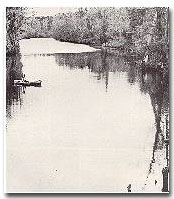OUR LEGACY - Early European Exploration
 The bayous and flat lands became the pathways by which Spanish explorers, occasional French traders and Anglo frontier adventurers visited the area. Soon after Columbus "discovered" America, Spanish explorers ranged into the territory in the vicinity of present-day Houston. Among them were Captain Alonzo Alverex de Pineda, who was the first to map the Texas coast in 1519, and Alvar Nunez Cabeza de Vaca. The latter was captured by the Karankawa Indians in 1528, after his ship was wrecked on the Galveston coast. He escaped and fled westward into the interior, were he lived for some six years among the local natives, calling them the "cow" nation in reference to the herds of buffalo they followed. Thus began Spain's long hegemony over Texas, which was, until 1836, a part of Mexico. Spanish influence remains strong in Houston today.
The bayous and flat lands became the pathways by which Spanish explorers, occasional French traders and Anglo frontier adventurers visited the area. Soon after Columbus "discovered" America, Spanish explorers ranged into the territory in the vicinity of present-day Houston. Among them were Captain Alonzo Alverex de Pineda, who was the first to map the Texas coast in 1519, and Alvar Nunez Cabeza de Vaca. The latter was captured by the Karankawa Indians in 1528, after his ship was wrecked on the Galveston coast. He escaped and fled westward into the interior, were he lived for some six years among the local natives, calling them the "cow" nation in reference to the herds of buffalo they followed. Thus began Spain's long hegemony over Texas, which was, until 1836, a part of Mexico. Spanish influence remains strong in Houston today.
In 1685, Rene Robert Cavelier, Sieur de la Salle, claimed all the lands west of the Mississippi River for King Louis XIV of France. La Salle built Fort Saint Louis near the site of present-day Port Lavaca, southwest of Houston. He camped at the headwaters of Cypress Creek in the greater Houston area in February 1687, and soon afterwards was murdered by members of his own party near Navasota to the northwest.
In the eastern part of Texas, competition between the French and Spanish characterized most of the eighteenth century. Trade routes, including the Spanish Atascosita Trail, which is now northern Harris County, stretched from Louisiana to the Rio Grande. However, neither the Spanish or the French successfully introduced permanent settlements or gained firm control of the area.






